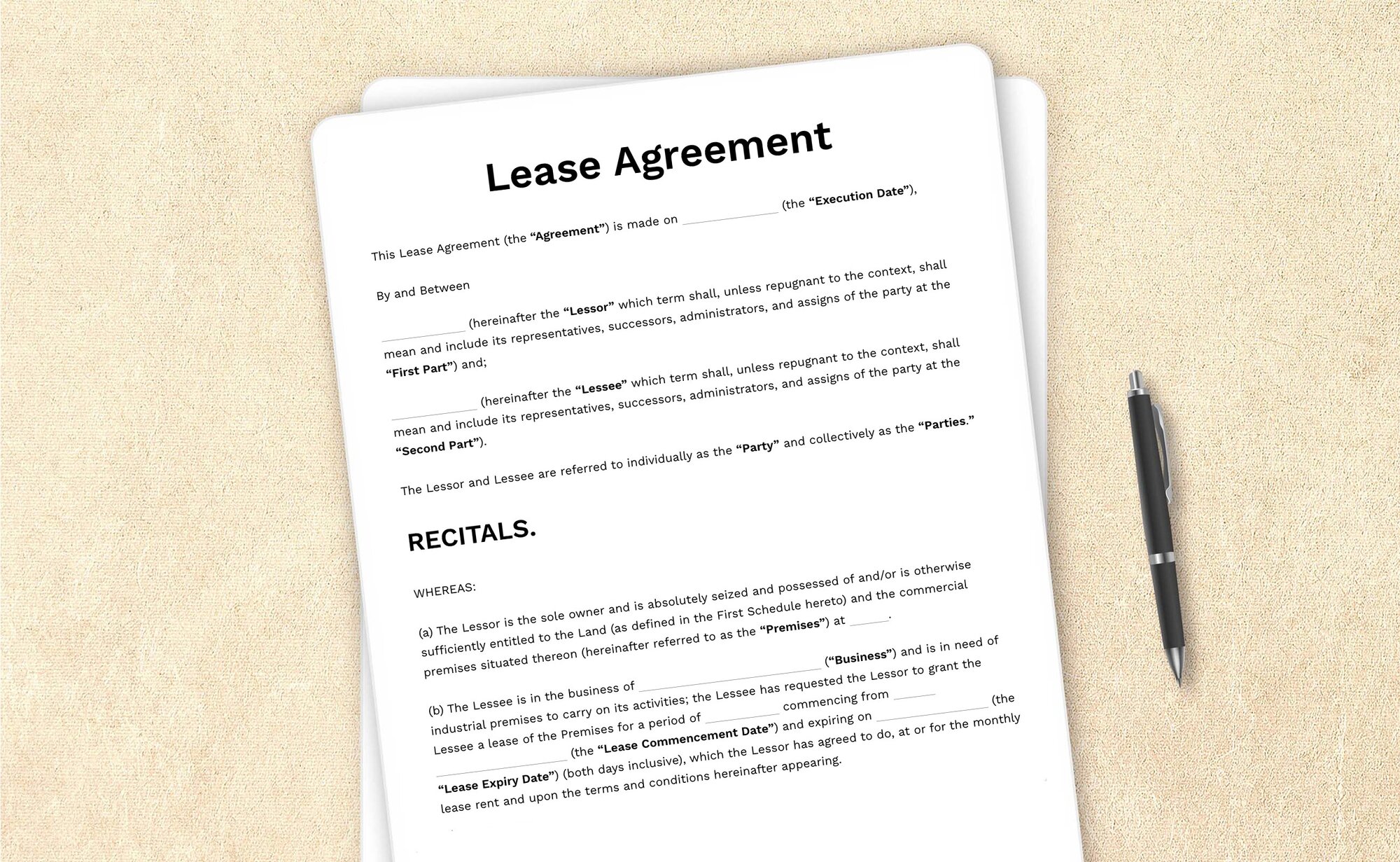How-to guides, articles, and any other content appearing on this page are for informational purposes only, do not constitute legal advice, and are no substitute for the advice of an attorney.
Lease agreement: How-to guide
Whether you're a landlord looking to protect your property or a tenant ensuring a safe and fair renting experience, having a comprehensive lease agreement is essential. It is the foundation of a secure rental relationship, setting expectations, defining rights, and protecting all parties involved. For landlords, it safeguards their investment. For tenants, it ensures they have a comfortable and predictable living situation.
In this guide, we’ll walk you through everything you need to know about lease agreements, or what people loosely refer to as 'rental agreements'—from their importance and types to tips for creating one that meets your needs. Let’s dive in.
What is a lease agreement?

A lease agreement is one of the most critical documents for landlords and tenants when renting a property. Simply put, it is a contract between the lessor (landlord) and the lessee (tenant). It outlines the terms and conditions under which the landlord allows the tenant to occupy and use the property in exchange for monthly rent payments.
Who needs a lease agreement?
Lease agreements are essential for anyone involved in property rental. Whether you’re a landlord renting out your home, a commercial property owner leasing office space, or a tenant looking for protection, having a well-drafted lease agreement is essential.
It clarifies rent payments, the lease termination date, security deposits, and property use, preventing unnecessary disputes.
The difference between a lease agreement and a rental agreement
Although the terms “lease agreement,” “rental agreement,” or “rental lease agreement” are often used interchangeably, they are different. Here’s how:
| Points of differences | Lease agreement | Rental agreement |
|---|---|---|
| Term | Remains fixed; long term | Month-to-month basis; short term |
| Benefit | Provides stability | Provides flexibility |
| Rent amount | Remain unchanged through the term | Can be adjusted frequently with a reasonable notice period |
Common types of lease agreements
Depending on the property type and the needs of the landlord or tenant, there are several types of lease agreements:
1. Residential lease agreement
The residential lease agreement is used when leasing homes, apartments, or condos. It outlines details like the rent amount, security deposits, rules about personal property, and lease terms.
2. Commercial lease agreement
Designed for leasing office spaces, retail stores, or industrial properties, a commercial lease agreement is more complex than a residential lease. It often includes clauses about property use, tenant responsibilities for maintenance, and lease termination dates.
3. Month-to-month lease agreement
This flexible arrangement works for situations where the tenant or landlord needs short-term commitments. It renews every month, seeks a monthly rent payment, and allows either party to terminate with reasonable notice, as outlined in local state lease agreements.
4. Fixed-term lease agreement
This document specifies a set duration, such as six months or a year. It provides stability for both parties and often includes penalties for breaking the lease early unless otherwise stated in the agreement.
5. Percentage lease agreement
A percentage lease agreement is a type of commercial lease where the tenant pays a base rent plus a percentage of their sales revenue. This is common in retail spaces like shopping malls, where landlords benefit when businesses do well.
6. Rent-to-own lease agreement
This type of agreement allows tenants to rent with the option to buy the property later. It’s ideal for those aiming to transition from renting to ownership.
7. Gross, net, and modified leases
- Gross lease: Tenant pays a flat rate, with the landlord covering operating expenses.
- Net lease: Tenant pays rent plus expenses like property taxes or utilities.
- Modified lease: A hybrid where responsibilities are shared between landlord and tenant.
Key components to include in your lease agreement

Let’s break down the essential elements your lease agreement template must have, using examples to clarify.
1. Recitals
This section sets the stage for the lease agreement. It provides an overview of the arrangement, such as the names of the landlord and tenant and the purpose of the lease.
Example: “This lease agreement is made between John Smith (landlord) and Jane Doe (tenant) for the rental of a residential property located at 123 Main Street.”
2. Terms and conditions
You outline the lease rules here, covering aspects such as payment schedules, tenant responsibilities, and conditions for breaking the lease.
Example: The tenant agrees to pay rent on the 1st of every month. If the payment is delayed beyond the 5th of a month, a late fee of $50 will be charged.
3. Acts of God (Force Majeure)
The Act of God clause protects both parties from unforeseen events like natural disasters or pandemics that may prevent either from fulfilling their obligations. Here is an example of what can be stated here:
Example: If a flood renders the property uninhabitable, the tenant may terminate the lease without penalty, and the landlord is not responsible for finding alternative housing.
4. Agreement
In this section, you need to formally state the lease's enforceability, confirming that both parties agree to the terms.
5. Amenities
List any additional facilities included in the lease, such as parking spaces, gym access, or appliances.
Example: The lease includes one reserved parking spot and access to the shared laundry room.
6. Applicable laws
Mention the state-specific landlord-tenant laws governing the lease.
Example: This lease agreement complies with California's landlord-tenant laws.
7. Grant of lease
This is the landlord's formal acknowledgment granting the tenant the right to occupy the property for the agreed period.
8. Handover of possession
Specify the date the tenant can move in and take possession of the rental unit.
Example: The landlord will hand over possession of the property on January 1, 2025.
9. Property details
Clearly describe the rental property. Include its address, size, and any distinguishing features.
Example: The property is a 2-bedroom, 1-bathroom apartment located at 123 Main Street, with a total area of 1,200 square feet.
10. Parties involved
List the names of the landlord, tenant(s), and any property managers involved.
11. Lease term
Define whether the lease is fixed-term or month-to-month, and specify the start and end dates.
Example: This is a fixed-term lease beginning January 1, 2025, and ending December 31, 2025.
12. Rent details
Include the rent amount, due date, late fees, and grace period.
Example: Monthly rent is $1,500, due on the 1st of each month. A grace period of 5 days is allowed, after which a $50 late fee will apply.
13. Security deposit
Detail the deposit amount, its purpose, and the conditions for its return.
Example: The tenant must pay a $1,500 security deposit to cover potential damages. If there is no damage, the deposit will be refunded within 30 days of lease termination.
14. Rules and regulations
Outline specific rules, such as noise limits, pet policies, and maintenance expectations.
Example: Pets are allowed with prior approval and a $200 non-refundable pet deposit.
15. Lease termination and renewal
Include clauses about how either party can terminate or renew the lease.
Example: Either the landlord or tenant must provide a 30-day written notice of lease termination. Renewal terms will be discussed 60 days before the lease ends.
16. Lessor’s and lessee’s covenants and warranties
Detail the obligations of both parties.
Example:
- The landlord agrees to maintain the property in habitable condition.
- The tenant agrees to notify the landlord of needed repairs promptly.
17. Inspection
Specify the move-in and move-out inspection process to document the property's condition.
18. Additional clauses
Include legal clauses to address specific scenarios:
- Indemnity: Include an indemnity clause to shield the landlord or tenant from liability for damages caused by the other's negligence.
- Waiver: Add a waiver clause to outline any specific exceptions to the agreed lease terms, ensuring clarity in unique situations.
- Severability: Incorporate a severability clause to guarantee the lease remains enforceable even if one provision is deemed invalid.
19. Further assurances and entire agreement
Ensure that both parties commit to following the lease terms and state that this document is the complete agreement.
20. Notices
Specify how notices should be given, whether by email, certified mail, or hand delivery.
21. Governing law
Mention the state laws that govern the lease.
22. Attorney and recording fees
Mention who bears legal and administrative costs in this arrangement.
23. Execution and counterparts
The execution and counterparts clause makes sure a lease is legally binding even if the landlord and tenant sign separate copies. This is helpful when both parties are in different locations or signing at different times. Each signed copy, or "counterpart," is considered part of the same official agreement.
Example: Let’s say a landlord in Missouri emails a lease to a tenant in North Carolina. The landlord signs their copy first, and the tenant signs theirs later. Even though they didn’t sign the same physical document, the lease is still legally binding because of the execution and counterparts clause.
24. Acceptance and signature
Include signature lines for all parties.
Example: "By signing below, both the landlord and tenant agree to the terms of this lease agreement."
US state laws on lease agreements
State laws govern lease agreements and outline the rights and responsibilities of landlords and tenants. These laws address key aspects such as security deposits, deadlines for returning deposits, and fair housing regulations.
For specific details, refer to your state's landlord-tenant laws.
Common legal considerations

Understanding key legal requirements can help both landlords and tenants avoid misunderstandings and stay compliant with laws.
1. Security deposit laws: Each state has limits on how much a landlord can charge as a security deposit and how long they can hold it after the tenant vacates.
Example: In South Carolina, landlords must return security deposits within 30 days of lease termination1 if the lease is by the month.
2. Notice periods for termination: Reasonable notice periods vary by state. It is important to be aware of and act in accordance with state laws to avoid unnecessary conflicts and penalties.
3. Rules for prorated rent and grace periods: Landlords often prorate rent if tenants move in mid-month. Additionally, states like Michigan may mandate grace periods to accommodate delayed payments.
Example: A tenant moving into a leased property on the 15th of the month may only pay for the remaining days instead of the full month.
4. Late fees and penalties: While landlords can impose late fees for overdue rent, these must be reasonable and align with state regulations.
Responsibilities of the lessor and lessee
A successful landlord-tenant relationship depends on understanding and fulfilling responsibilities on both sides. Clear communication, a solid rental agreement, and adherence to state-specific laws are essential. Here’s a closer look at the duties of both the lessor (landlord) and lessee (tenant), along with actionable tips to navigate this relationship smoothly.
Responsibilities of the lessor
1. Providing a habitable property: Landlords are required to ensure that the rental unit is safe and meets all local housing codes2. This includes functioning utilities, proper heating or cooling, and secure structural elements.
Example: A landlord renting an apartment in Rhode Island must comply with state statutes, ensuring working smoke detectors and pest-free living conditions.
2. Maintaining the property: Repairs and routine maintenance are part of the landlord’s responsibilities unless otherwise stated in the lease agreement.
Example: If a tenant reports a broken water heater, the landlord is obligated to repair it within a reasonable time frame.
3. Respecting tenant privacy: As mentioned by your state laws, landlords can’t enter the rental unit without proper notice3, which is typically 24–48 hours.
4. Handling the security deposit properly: State laws govern how landlords manage4 security deposits. For instance, Missouri limits the deposit to two months’ rent and requires its return within 30 days5 of lease termination.
Responsibilities of the lessee
1. Paying rent on time: The tenant’s primary duty is to pay rent according to the lease agreement, including adhering to due dates, grace periods, and late fee terms.
2. Taking care of the property: Tenants must keep the rental property clean and notify the landlord of any damage or needed repairs.
3. Complying with lease terms: Tenants must follow the rules outlined in the lease, including pet policies, noise limits, and the use of amenities.
4. Providing proper notice for lease termination: State laws require tenants to give reasonable notice before ending a lease. For example, in Michigan, this is typically a 30-day notice for month-to-month agreements.
Lessor and lessee checklist: What to know before signing
For lessors (landlords)
- Screen tenants carefully: Use tenants' credit reports and thorough rental applications to ensure reliability.
- Understand state-specific laws: To avoid legal issues, familiarize yourself with your state's statutes.
- Document everything: Keep records of communications, maintenance requests, and rent payments for clarity and accountability.
For lessees (tenants)
- Read the lease thoroughly: Ensure you understand all terms, from lease termination dates to rules about the security deposit.
- Know your rights: To avoid disputes, be aware of local statutes because they outline your responsibilities as a tenant, set rules for rent payments and security deposits, and protect you from unfair practices.
- Communicate promptly: Inform your landlord about repairs or changes, such as needing to prorate rent when moving in mid-month.
Why use a LegalZoom lease agreement template?
Creating a lease agreement with LegalZoom is quick and hassle-free. Here’s how it works:
- Customize your lease: Use LegalZoom’s rich editor to fill in key details like rent amount, lease term, and security deposit. Adjust clauses to fit your rental property.
- Download instantly: Once complete, get your printable lease agreement template in a ready-to-use PDF format.
- Sign online: Use the eSignature feature to finalize the agreement without printing or mailing.
LegalZoom’s lease agreement templates save you time and effort, making renting simple for both landlords and tenants.
Frequently asked questions
Can a lease agreement be changed?
Yes, but changes require mutual consent from both the landlord and tenant. Updates should be documented in writing and signed by all parties.
Can I terminate a lease early?
Early termination is possible but may involve penalties, such as forfeiting the security deposit or paying additional rent, depending on the lease terms and state laws.
What happens if a tenant fails to pay rent?
Non-payment can lead to late fees, eviction notices6 or legal action. Grace periods may allow tenants extra time before penalties are enforced.
Sources
- Landlord and Tenant Law in South Carolina: https://www.scjustice.org/brochure/landlord-tenant-law-south-carolina/
- Healthy Housing Codes: https://nchh.org/information-and-evidence/healthy-housing-policy/state-and-local/healthy-housing-codes/
- Landlord Entering Your Unit: https://dcba.lacounty.gov/portfolio/landlord-entering-your-unit/
- Security deposits and last month's rent: https://www.mass.gov/info-details/security-deposits-and-last-months-rent
- Landlord Tenant Law: https://ago.mo.gov/get-help/programs-services-from-a-z/landlord-tenant-law/
- Failure to Pay Rent: https://www.peoples-law.org/failure-pay-rent
